Art & Exhibitions
MoMA Curator Paola Antonelli on Why Fashion May Be ‘Modern’—But It’s Still Not Art
What the fashion exhibition "Items: Is Fashion Modern?" can teach us about the making of history.
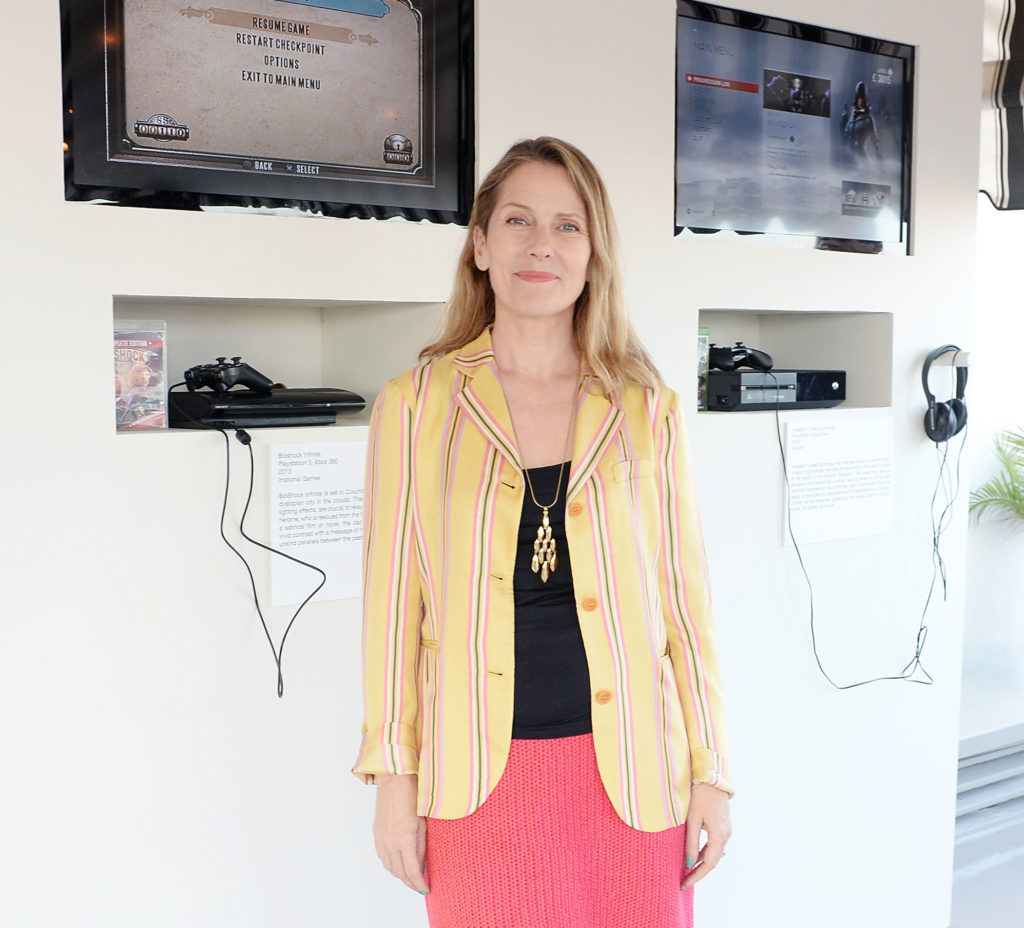
What the fashion exhibition "Items: Is Fashion Modern?" can teach us about the making of history.

Max Berlinger

Fashion exhibitions at museums, from the Metropolitan Museum of Art’s blockbuster show on Rei Kawakubo’s avant-garde brand Comme des Garçons to the Balenciaga show at London’s V&A Museum, are probably only going to get more popular. They attract record crowds, which is good for the museums, and they give the once lowly rag trade a patina of the intellectual, which makes them feel good—so everyone wins. And while these shows typically focus on either a specific designer or theme, MoMA’s new exhibition “Is Fashion Modern?” seeks to pull the focus back and look at the complex way that clothing fits into our lives, and what the apparel we wear says about who we are.
It’s some pretty heady stuff, but the exhibition’s curator, Paola Antonelli, posits that fashion is an integral point of our daily lives—and, of course, she’s right—so it deserves to be considered with as much thoughtfulness as works of art.
The exhibition displays more than 100 items, ranging from the humble and familiar (T-shirts, briefs, red lipstick, safety pins) to the more ornate (Hermès Birkin bags, the Cartier Love bracelet). It also asks young designers to propose updated “responses” to the archetypical garment. Recently, we spoke to Antonelli as she was hanging the exhibition in MoMA’s galleries to discuss her definition of modernity, what she learned while curating this show, and whether or not she considers fashion art.
How did the idea for this exhibition come to you?
It has been long in the making. I started at MoMA about 23 years ago and I noticed that there was no fashion in the collection—there was like one Fortuny dress. So I started thinking about it at that time, but there were so many other priorities. But I kept it in the back of mind. About 10 years ago I started this list called “garments that changed the world”—objects that that I thought were important and could be part of the collection, because I always believed that you cannot tell a complete history of architecture and design without including garments and fashion, both utilitarian garments and more expressive, individualist ones.
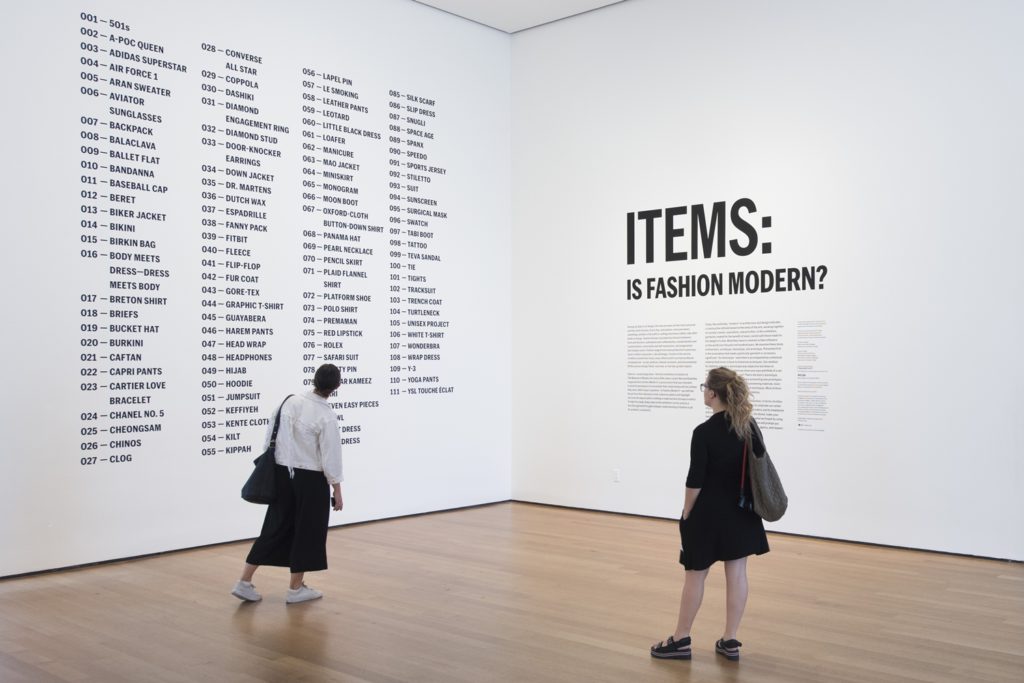
Installation view of “Items: Is Fashion Modern?” at the Museum of Modern Art, New York. © 2017 The Museum of Modern Art. Photo by Martin Seck.
So I was keeping this list and Glenn Lowry, the director of the museum, knew it. And one day he asked me if I thought about making [the list] into an exhibition. So that’s how it started. It’s been long time in the thinking; in the making it’s been about a year and a half.
I have to say, during these 23 years we’ve included more pieces of fashion in the collection, but always in an organic way—like there was an exhibition called Humble Masterpieces and so we included the white T-shirt, or I was doing an exhibition about design and safety and we included in the collection the Final Home parka for the homeless, or this dress that was 3-D printed. We were always including garments with different pretexts. In this case, we’re embracing it wholeheartedly. We’re tackling fashion as a form of design.
The show is called “Is Fashion Modern?” What does “modern” mean to you?
“Modern” is one of those words that’s so filled with meaning and means different things to different people, but because this is the Museum of Modern Art, it’s central to our being. At the same time, it’s quite personal. It’s not completely objective. A working definition—well, a description, not a definition—is that it’s usually a design attitude about goals and means: You set a goal and you reach it through certain means at your disposal, usually technology. And you really try to make sure you push the world a little bit forward with what you do. It’s never historiographic or like post-modernism which is harking towards the past. It’s always about the future, even though it takes tradition and the past into account. Also, there’s a certain transparency in the way the design process works. Usually at the end, when you look at an object you can understand the initial idea of the designer. So it’s a progressive, constructive attitude that you can see reflected in the final object.
Of course the white T-shirt is certainly understandable, but when you look at Comme des Garçons and Rei Kawakubo, the “Body Meets Dress collection,” it’s made of gingham and has all this padding and protuberances. I love it because the progressive part of that particular collection is getting people to understand that bodies are not all perfectly symmetrical. I found that to be such an amazing breakthrough. It’s a very compassionate, progressive stance. If you look at the white briefs, they’re very functional—it’s about going to the bathroom while standing and without having to completely disrobe—one is quite functional and one is more expressive but they’re both modern because they add to the history of design.
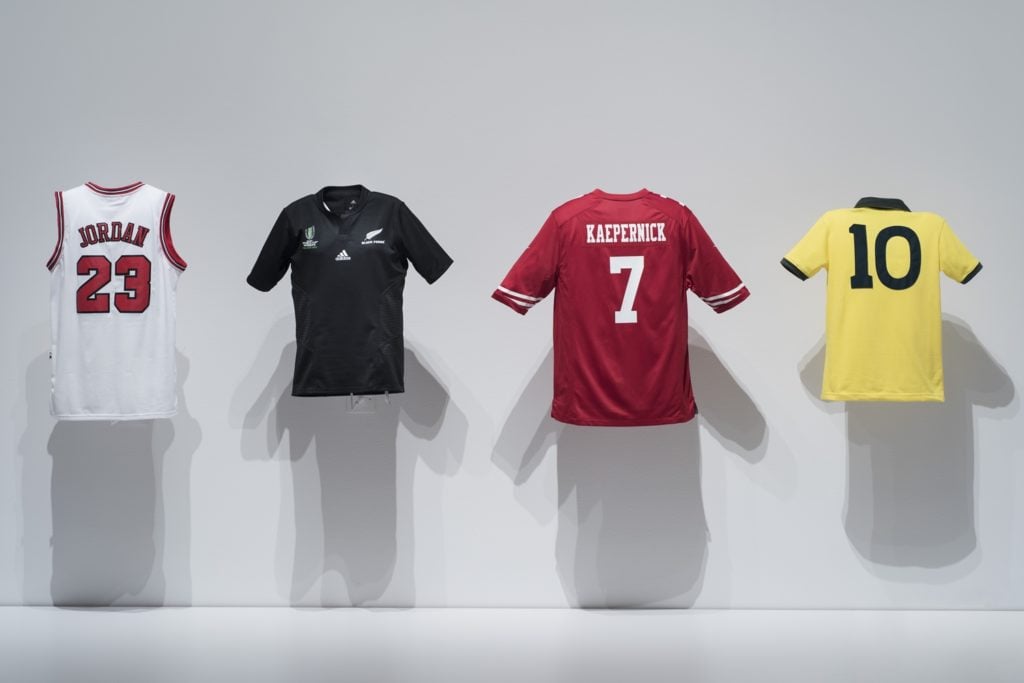
Installation view of “Items: Is Fashion Modern?” at the Museum of Modern Art, New York. © 2017 The Museum of Modern Art. Photo by Martin Seck.
Does your criteria for modernity change from piece to piece?
Well, when you work with design you always take the context into account. When you do an exhibition you have different criteria than when you chose objects for the collection. In the case of this exhibition, the criteria is, of course, good design, but also the formal expression. The main criterion is influence: Is it good design and is it formally interesting, but also was it influential in the world in the past 100 years? So the white T-shirt and the little black dress are chosen with the same criteria in mind. And pretty much all the objects included have had a strong impact on the world, even if they’re very rarefied. Going back to that Rei Kawakubo dress, even if very few people can afford it, or can afford to wear it, it was still so influential among designers that I bet the clothes we’re wearing today are carrying a little bit of the DNA of that collection.
I’d say that we chose objects of consequence. The consequences aren’t just cultural—sometimes it’s about economics or politics. So if you look at the hoodie, its impact as a symbol of prejudice, or if you look at the turtleneck or the hijab, they’re very interesting garments with some controversy attached to them which have introduced the idea of modest fashion, which is a very contemporary idea. It’s incredible that each of these items can be looked at from different angles and serve as a lens to look at fashion, manufacturing, and our world in a different way.
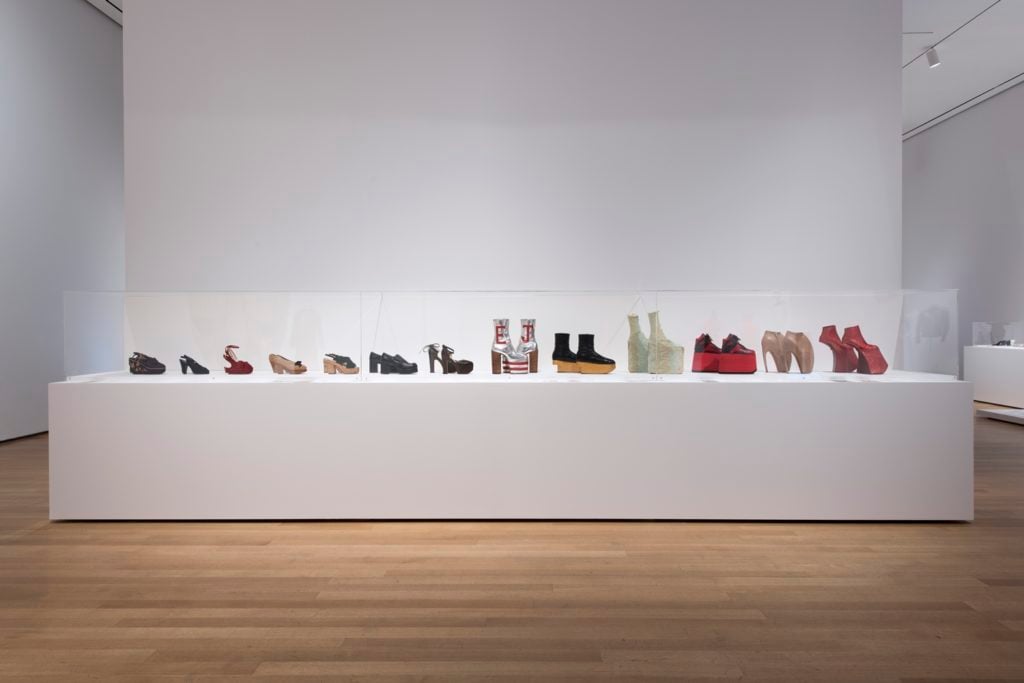
Installation view of “Items: Is Fashion Modern?” at the Museum of Modern Art. Photo by Martin Seck.
Did anything surprise you during the process of curating this show?
Oh, so many. First of all, I had never done a fashion show. I’m not a fashion expert so this was an amazing learning curve. One of the hardest things was working with mannequins. It’s really difficult! First of all, mannequins have presence, so the choices you make—with head, without head, which color, you can get invisible mannequins, what pose they’re in—it’s really a big deal.
Also, they only exist in size zero and size two. If you want a mannequin that corresponds to a real American woman, which is a size 16 on average, it’s almost impossible. I have a mannequin that’s a size 10 for an installation and it was not easy to get. So even seeing how garments are displayed was eye opening.
One of the interesting discoveries was this company New Breed that was based in Harlem in the 1970s. It was doing all sorts of clothing but was known for dashikis, but like New York dashikis, not the colorful dashikis, more like cool New York ones. It was just so interesting to find all the images related to it.
There’s a surprise in every single piece. One of the people on my team, Michelle Fischer, became obsessed with maternity clothes, which have such an interesting story. They are really a segment of the population that’s not catered to at all, they are an afterthought for so many designers and stores.
In an interesting move, you commissioned designers to create new “takes” on some of these classical archetypes. What was the thinking behind that?
I was telling you that the idea of modernity is to push things forward and so I wanted that. I wanted to give the opportunity to newer designers, and even scientists in some cases, to propose new versions. For instance the jumpsuit: We worked with this wonderful Irish designer Richard Malone, who has been looking at jumpsuits for a long time. He really admires the utopian and working-class aspects of the jumpsuit and the way he approaches them is fantastic, so he created a prototype for us.
Another example is the young designer Lucy Jones, who works with differently-abled bodies, usually people in wheelchairs. So she designed a pantyhose for people in wheelchairs so that they can wear them without getting up. There’s Kerby Jean-Raymond of the New York brand Pyer Moss, and he interpreted Pierre Cardin’s Cosmos collection for contemporary times. Cardin’s Cosmos collection is from the 1960s and it was thinking about the Space Age and humanity conquering other planets. But Kerby instead looked at the future on planet Earth—the water is rising and so we’ll need to float. So even though it recalls Cardin, it’s not about space, it’s about being here. And the funny thing is that with the past few weeks what’s going on here in Texas, Florida, and Puerto Rico really brings it home in a tragic way.
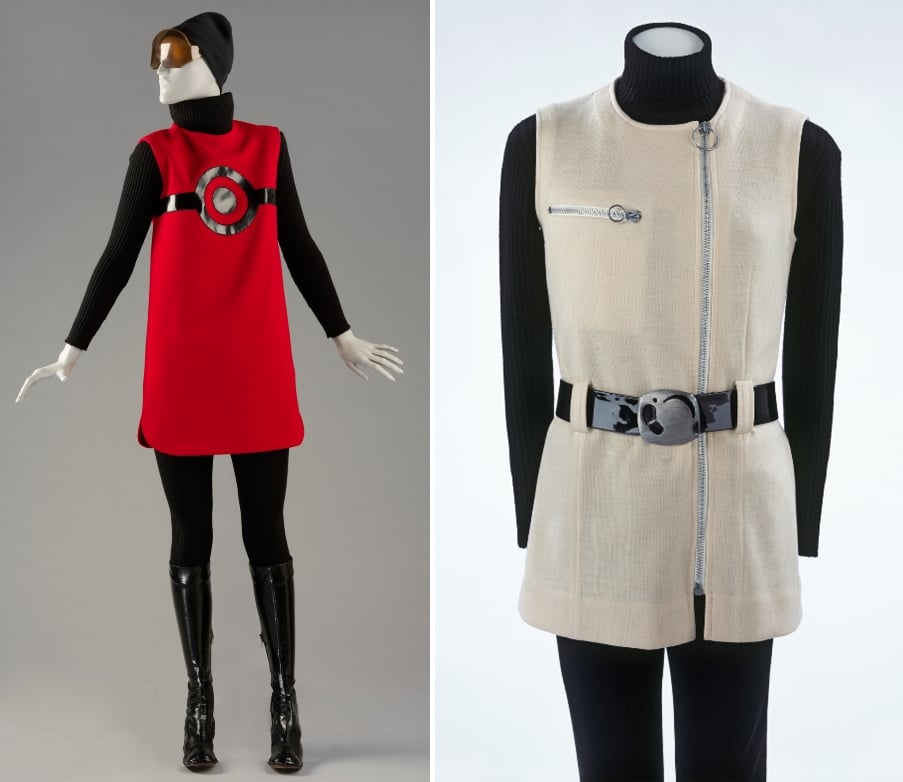
Left: Pierre Cardin’s Cosmos day ensemble (1967) and, right, the Cosmos man’s ensemble (1967). Images © Victoria and Albert Museum, London 2016.
There are also prototypes and commissions that introduce new textiles, like the company Modern Meadow that has just introduced a liquid leather. It is actual leather, the collagen was grown in vats and it was tanned, but it can be grown in sheets so there’s no flaws and there’s none of the waste that you normally have with leather. There’s another company called Bolt Threads that deals with spider silk. They’re showing it for the first time in a dress designed by Stella McCartney.
We were talking about “modern” and you know modern can be an attitude that goes back centuries, it’s not about the 20th century per se. The conversation between the past, present, and future was important to us.
Is there a piece that you feel especially connected to, or that is your favorite?
It’s so hard, I like them all, but there’s a pair of Margiela Tabi ballerina shoes. They’re a silver foil that is just amazing, I keep looking at them and lusting after them. But that’s just personal lust. Probably one of my favorite pieces is this small—it’s diminutive in scale—body shape for plus-size bodies. Two scholars were trying to design a mannequin for a plus-size body and what they did was mathematically look at normal mannequins and amplified them. Now there’s a beautiful figurine that kind of looks like the Paleolithic Venus. It’s just fantastic.
As its curator, what do you hope for people to take away from the show?
Very simply, I want them to think of what they wear in a different way, with more respect, more responsibility, with more appreciation. It’s not about making people feel heavy or preaching, it’s just about appreciation. It’s about what’s around and behind these garments that we wear.
Do you think fashion is art?
No, I never frame objects as art pieces, I frame them as design. I think that there’s a fundamental difference: context. I always think the only real difference between art and design is that an artist can choose to be responsible toward other human beings or not, a designer always has to, by definition. So when I put objects in an exhibition, I’m always stressing the fact that they’re design not art. You should never take the object at face value, you should revel in its shape, where it’s from, what it’s doing, and whether it works for you. Objects of design are ultimately works for other people, so the viewer is the ultimate judge of the importance of the object. I know that most people are more used to dealing with art and I always have to stress that these are design exhibitions.
This interview has been condensed and edited for clarity.